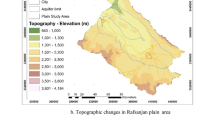Abstract
The quality of groundwater was assessed by determining the physicochemical parameters (pH, EC, TDS and TH) and major ions concentration (HCO3, Cl, FSO4, Ca, Mg, Na and K) around Dindigul district, Tamil Nadu, India. The groundwater samples were collected from 59 bore wells covering the entire study area and analyzed using standard methods. The GIS mapping technique were adopted to highlight the spatial distribution pattern of physicochemical parameters and major ion concentration in the groundwater. Gibbs diagram reveals that the source of major ions is predominantly derived from rock–water interaction and evaporation dominance process. The salt combinations of the aquifers are dominated by CaHCO3, mixed CaMgCl, mixed CaMgHCO3 and CaCl facies type due to leaching and dissolution process of weathered rocks. The Canadian Council of Ministers of Environment Water Quality Index (CCMEWQI) suggests that most of the groundwater quality falls under good to marginal category. The statistical analysis indicates that the presence of major ions and physicochemical parameters are chiefly controlled by rock–water interaction and residence time of the groundwater. However, the major nutrient like nitrite in the groundwater probably comes from anthropogenic process. Based on the groundwater quality standards, majority of the samples are suitable for drinking purposes except few in the study area.









Similar content being viewed by others
References
APHA (1995) Standard methods for the examination of water and waste water, 19th edn. American Public Health Association, Washington DC, pp 1–467
Bhardwaj V, Singh DS, Singh AK (2010) Water quality of the Chhoti Gandak River using principal component analysis, Ganga Plain, India. J Earth Syst Sci 119(1):117–127
Billings RJ, Berkowitz RJ, Watson G (2004) Teeth. Pediatrics 113:1120–1127
Bureau of Indian Standards (1993) Drinking water specification IS: 10500
Burrough, McDonnell (1998) Principles of geographical information systems for land resources assessment. Oxford University Press, New York, pp 1–333
Canadian Council of Ministers of the Environment (CCME) (2001) Canadian water quality guidelines for the protection of aquatic life: CCME Water Quality Index 1.0, Technical Report, Canadian Council of Ministers of the environment winnipeg, MB, Canada. http://www.ccme.ca/sourcetotap/wqi.html. Accessed 30 Aug 2012
Das M, Kumar A, Mohapatra M, Murali SD (2010) Evolution of drinking quality of groundwater through multivariate techniques in urban area. Environ Monit Assess 166(1–4):149–157
Fewtrell L (2004) Drinking-water nitrate, methemoglobinemia, and global burden of disease: a discussion. Environ Heal Perspect 112(14):1371–1374
Gibbs RJ (1970) Mechanism controlling world water chemistry. Sciences 170:795–840
Giridharan L, Venugopal T, Jayaprakash M (2008) Evaluation of the seasonal variation of the geochemical parameters and quality management of the groundwater in the proximity of River Cooum, Chennai, India. Environ Monit Assess 143(1–3):161–178
Hem JD (1985) Study and interpretation of the chemical characteristics of natural water: U.S. Geological Survey Water-Supply Paper 2254, 3rd edn., 263 p
Krishna Kumar S, Chandrasekar N, Seralathan P, Godson PS, Magesh NS (2011) Hydrogeochemical study of shallow carbonate aquifers, Rameswaram Island, India. Environ Monit Assess. doi:10.1007/s10661-011-2249-6
Lumb A, Halliwell D, Sharma T (2006) Application of CCME water quality index to monitor water quality: a case of the Mackenzie River basin, Canada. Environ Monit Assess 113:411–429
Magesh NS, Chandrasekar N (2011) Evaluation of spatial variations in groundwater quality by WQI and GIS technique: a case study of Virudunagar District, Tamil Nadu, India. Arab J Geosci. doi:10.1007/s12517-011-0496-z
Magesh NS, Chandrasekar N, Vetha Roy D (2011) Spatial analysis of trace element contamination in sediments of Tamiraparani estuary, southeast coast of India. Estuarine Coastal Shelf Sci 92(4):618–628
Piper AM (1944) A graphical interpretation of water—analysis. Trans Am Geophys Union 25:914–928
Ramachandramoorthy T, Sivasankar V, Subramanian V (2010) A seasonal quality assessment on portability of fresh shallow aquifers along the Rameswaram-Dhanuskodi coastal tract, India. Environ Monit Assess 160:127–139
Sarath Prasanth SV, Magesh NS, Jitheshlal KV, Chandrasekar N, Gangadhar K (2012) Evaluation of groundwater quality and its suitability for drinking and agricultural use in the coastal stretch of Alappuzha District, Kerala, India. Appl Water Sci. doi:10.1007/s13201-012-0042-5
SPSS (2001) SPSS for Windows, Rel. 11.0.1. 2001. Chicago: SPSS Inc
Subba Rao N (2006) Seasonal variation of groundwater quality in a part of Guntur district, Andhra Pradesh, India. Environ Geol 49:413–429
Sunitha V, Sudarsha V, Rajeswara Reddy B (2005) Hydrogeochemistry of groundwater, Gooty area, Anantapur district, Andhra Pradesh, India. Pollut Res 24(1):217–224
USEPA (2002) National water quality inventory: 2000 Report. U.S Environmental Protection Agency, Washington, DC, Office of Water, EPA-841-R-02-001
Ward JH (1963) Hierarchical grouping to optimize an objective function. J Am Stat Assoc 58(301):236–244
WHO (1971) Guidelines for drinking-water quality, VOL. 1 Recommendations, Geneva, p 130
Wilcox LV (1955) Classification and use of irrigation waters, USDA Circular No. 969, pp 19
Author information
Authors and Affiliations
Corresponding author
Rights and permissions
About this article
Cite this article
Magesh, N.S., Krishnakumar, S., Chandrasekar, N. et al. Groundwater quality assessment using WQI and GIS techniques, Dindigul district, Tamil Nadu, India. Arab J Geosci 6, 4179–4189 (2013). https://doi.org/10.1007/s12517-012-0673-8
Received:
Accepted:
Published:
Issue Date:
DOI: https://doi.org/10.1007/s12517-012-0673-8




